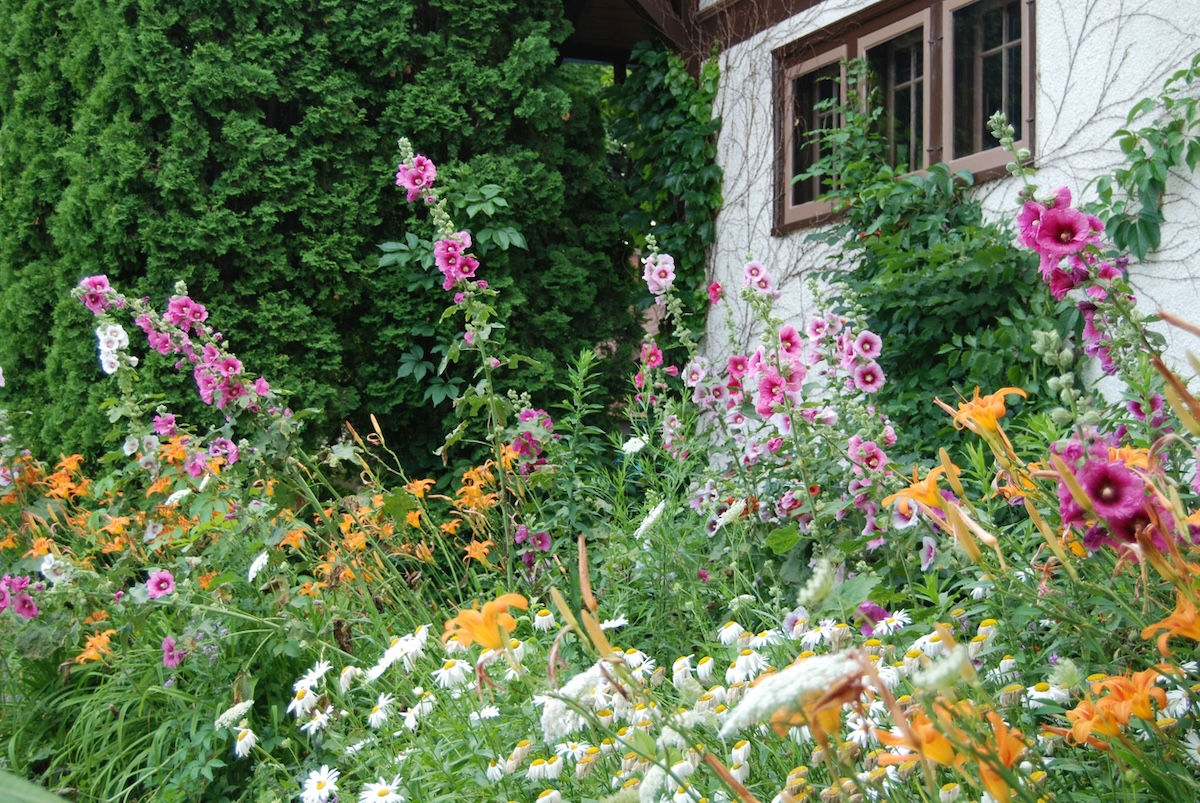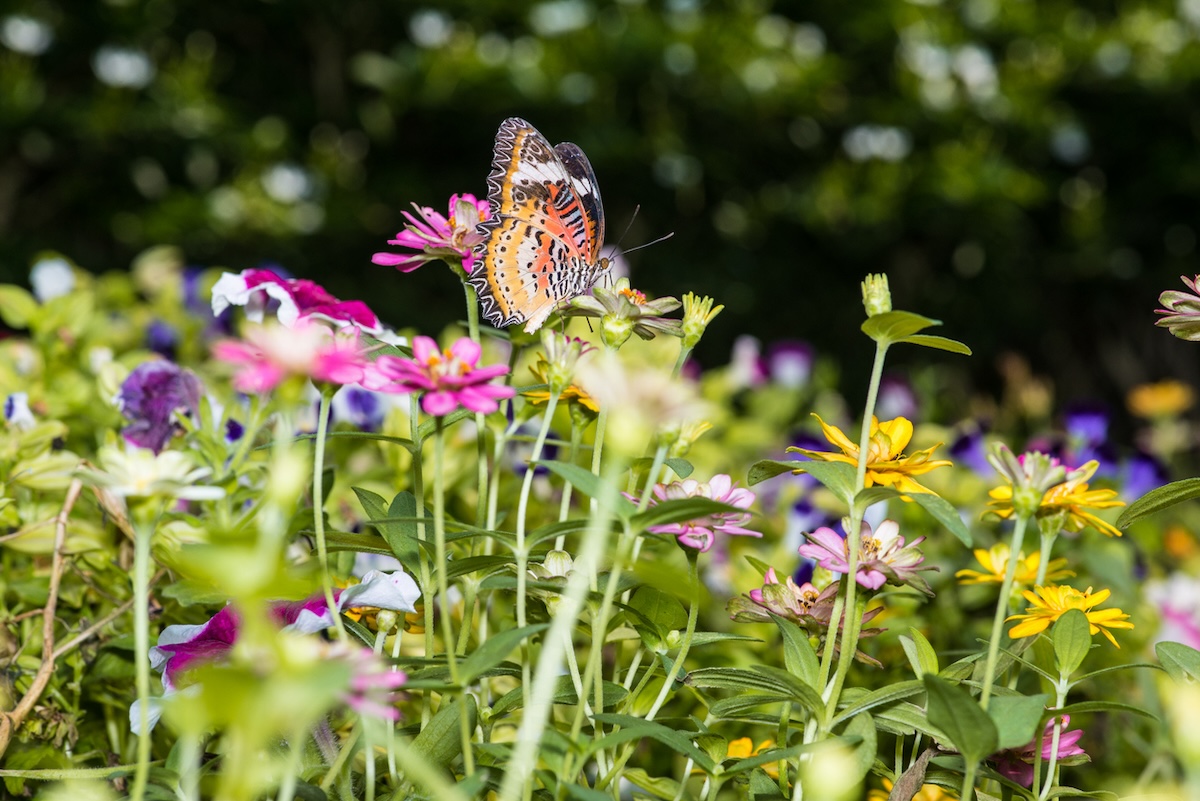

We may earn revenue from the products available on this page and participate in affiliate programs. Learn More ›
Chaos gardening is not a new concept. It has been around for some time and is characterized by a free-spirited approach to gardening, incorporating elements of spontaneity and natural growth patterns. This style often involves using old seeds, encouraging self-seeding plants, and embracing a more relaxed and organic gardening method, fostering a deeper connection with nature. “It is a fun way to express yourself by embracing the beauty of randomness and the joy of seeing the unexpected unfold,” says Russell Taylor, vice president of Live Earth Products, Inc., in Emery, Utah.
Chaos gardening involves scattering a diverse blend of seeds across your outdoor space and observing the natural selection process as plants compete for sunlight, space, and nutrients. “That is the central idea of chaos gardening,” explains Taylor, “Instead of an organized planting of flowers neatly arranged in rows, one allows random colors and shapes to form organically and have a natural wildflower-like appearance.”
This gardening movement has gained popularity as a viral trend in the past year, particularly on platforms like TikTok, garnering millions of views as a carefree and creative way to cultivate plants and embrace a wild and natural aesthetic.
What are the benefits of chaotic gardening?
Chaos gardening goes beyond just a gardening technique; it’s a philosophy. It promotes embracing unpredictability and enjoying the natural evolution of the garden. This approach can lead to a resilient ecosystem because the diverse plant species that arise can better withstand pests, diseases, and changing climate conditions. Additionally, chaos planting attracts a wide range of pollinators, which enhances local biodiversity.
Adding native plants will benefit biodiversity in the future. “Native plants are adapted to your local soil type and require less maintenance and fewer fertilizers,” Taylor explains, “By choosing native species, gardeners can support local wildlife, including insects and birds, which contributes significantly to the health of local ecosystems.”

What types of environments are best suited for chaos gardening?
“The exciting part about chaos gardening is adapting your seeds to thrive in almost any planting environment,” says Taylor. Chaos gardening flourishes in diverse conditions, particularly those that value natural diversity and require minimal intervention.
Ideal settings include native landscapes rich in biodiversity, low-maintenance areas such as wildflower meadows, pollinator gardens, and even suburban lots where a blend of order and wildness creates a harmonious balance. These environments allow for the spontaneous growth of various plant species, promoting ecological resilience and creating vibrant, thriving ecosystems without the need for strict control or excessive maintenance. “Make sure to check the recently updated USDA Plant Hardiness Zone [Map] and choose plants that are suitable for your region,” suggests Taylor. “Selecting plants for full sun or shade is also advisable if you want your chaos planting to thrive,” he adds.
What are the biggest challenges one might face when starting a chaos garden?
“One of the initial challenges is letting go of control and surrendering to the unpredictability of the garden’s development,” says Taylor. Starting a chaos garden entails challenges such as balancing diverse plants with varying needs, which can be daunting. “Seed and plant selection is fun but also requires a little homework, as you need to learn about the growth habits of the plants,” says Taylor. He also warns that it’s important to understand that some plants are incredibly prolific and can take over an area, making them a poor choice for random planting.
Allowing plants to grow freely is a key aspect of chaos gardening, but it also increases the risk of weeds, which requires proactive control measures. Effectively utilizing space without overcrowding or neglecting plants is crucial for success. Additionally, transitioning from traditional gardening methods to embracing chaos gardening might involve a learning curve for gardeners.

What are some common misconceptions about chaos gardening?
There are misconceptions about chaos gardening, such as the belief that it requires no maintenance. According to Taylor, while this is a low-maintenance approach, some care, such as soil health management, thinning after planting, and occasional weeding, is necessary.
The next misconception is that chaos gardening requires no planning. Unlike guerilla gardening, which often involves spontaneous and sometimes unauthorized cultivation in public spaces, chaos gardening requires a thoughtful approach. While it embraces a more organic and spontaneous planting method, chaos gardening still necessitates strategic decision-making regarding plant selection, spacing, and environmental considerations.
Another misconception is that chaos gardens are messy. This isn’t always the case. Taylor explains that when managed well, these gardens can be incredibly beautiful and vibrant. Through thoughtful design and care, chaos gardens can transform into captivating landscapes that capture the essence of wild beauty while still maintaining a sense of order and allure.
What do you need to get started with a chaos flower garden?
One of the best things about starting a chaos garden is that you don’t need a lot of garden tools. In fact, it doesn’t cost much to get started. As with any garden, the best results come about by starting from the ground up.
“A key factor in the success of any garden is enhancing your soil’s organic matter,” says Taylor. “Adding compost and humate enriches the soil, building active and stable forms of organic matter that improve soil structure. This step is crucial for supporting the diverse plant life in a chaos garden,” Taylor says. Once the soil is ready, you can select a diverse chaos garden seed mix containing seeds for flowers, vegetables, and herbs, including new and older seeds from previous seasons. Plant according to seed pack directions. Ensure regular watering and maintenance of the garden to promote germination and ongoing growth, paying attention to watering and weeding as necessary.

Final Thoughts
A chaos garden is a living work of art, constantly in motion. While this concept might sound like dream gardening, it takes some planning. However, the results can be stunning. Taylor says to picture your garden as a canvas, where instead of meticulously portraying every detail, you unleash your creativity and scatter colors across the space in a manner reminiscent of Jackson Pollock’s art.
By haphazardly sowing seeds, you invite the emergence of unforeseen color combinations and textural contrasts, resulting in a garden that undergoes a metamorphosis from week to week and year to year. This ever-changing landscape promises an ongoing sense of wonder and delight for the gardener and the local wildlife.
